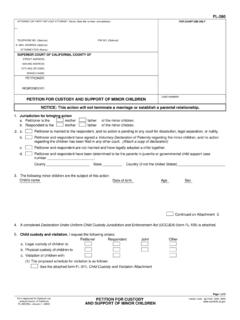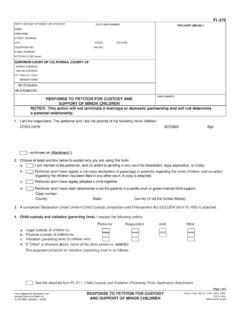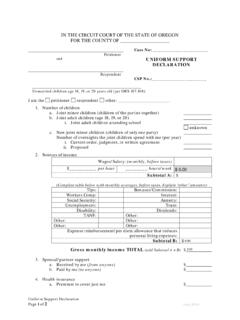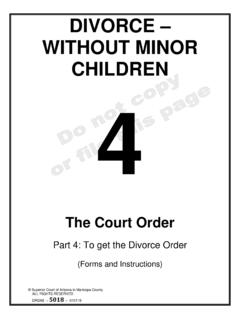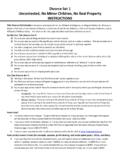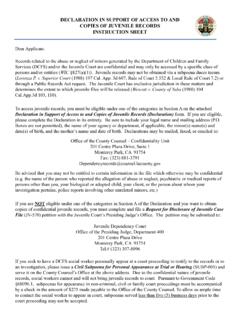Transcription of Clara Wieck-Schumann: Piano Trio in G minor, Op. 17 ...
1 Note: These set works guides are Pearson s interpretation of the set works and every effort has been made to ensure these are appropriate for use in the classroom. There may be other interpretations which are also valid and any such differences would not be considered errors, or require any updates to the guides. Clara Wieck-Schumann: Piano Trio in G minor , Op. 17, movement 1 (For component 3: Appraising) Background information and perfor mance circumstances The composer Clara (Wieck) Schumann was born in Leipzig, Germany, in 1819 and died in Frankfurt in 1896. She was best known in her lifetime as a concert pianist, but her reputation as a composer has grown in recent years as her works have been rediscovered.
2 Despite the success of several 19th-century female novelists around Europe, female composers, during Clara s lifetime (and beyond), were neither expected nor encouraged! She was brought up by her father, Friedrich Wieck, a gifted Piano teacher, and began her performing career as a child. In her teens Clara performed around Europe, laying the foundations for a lifelong career. The composer Robert Schumann was a pupil of Clara s father, and despite Friedrich s opposition to the match (taken all the way to a court case!), the two married in 1840. Clara had composed as part of her musical education with her father, producing a Piano Concerto (which she performed, with Mendelssohn conducting) at the age of 15 and continuing to produce works at a good rate into early middle age.
3 Most of her works feature the Piano , either as a solo instrument, as part of an ensemble, or as an accompaniment. Clara s composing decreased as her family responsibilities became more and more difficult (she gave birth to eight children, but only four survived). In addition to running the household, she was also the main breadwinner as Robert Schumann earned little money as a composer and later in life suffered from mental illness, causing his final years to be spent in an asylum. Clara knew, and worked, with Joseph Joachim, one of the leading violinists of the 19th century. She also knew, and had famous correspondence with, Johannes Brahms, whose composing she encouraged.
4 The piece The Piano Trio ( Piano , violin and cello) was one of the most important forms of chamber music from the late 18th to well into the 19th century. Note: These set works guides are Pearson s interpretation of the set works and every effort has been made to ensure these are appropriate for use in the classroom. There may be other interpretations which are also valid and any such differences would not be considered errors, or require any updates to the guides. Much chamber music was written for performance in the salons of the patrons and performers. Concert performances of trios such as this became more common as the century progressed. Clara Schumann, as a professional, would probably have played her trio in both the salon and the concert hall.
5 Composers in the Classical style, such as Mozart and Haydn, had established the form, and Beethoven and Schubert developed it further in the early Romantic style. Clara would have performed this core repertoire and this made the trio a natural outlet for her creativity. The piece was written in 1846, a year in which she gave the premiere of Robert Schumann s Piano concerto and had her fourth child. It is one of only a few multi-movement works in her oeuvre, following the full four-movement pattern of the genre: o Allegro moderato G minor o Scherzo and trio B /E o Andante G major o Allegretto G minor . Performing forces and their handling The instruments are given fairly equal roles in this movement, unlike many Piano trios, where the Piano dominates.
6 Although not without difficulty, none of the parts here are particularly virtuosic, perhaps being intended for performance by capable amateurs, as well as by professional musicians. Violin and cello use double-stopping, both at loud dramatic moments (bars 284 286) and to fill in the texture during quieter passages (bars 73 77). The violin plays mainly in the two octaves above its lowest string, but it does have music that stretches nearly another octave above this at times. The cello uses both its resonant low range and its powerful upper range, up to an octave above middle C at times. The cello provides: o support for the bass of the harmony at times, including pedal notes (bars 73 80).
7 O tenor-like mid-range parts to outline inner parts (bars 37 41). o material high in its register (bars 134 138; note that the notation here is in the treble clef, but written an octave higher than it sounds). The Piano provides both melodic and accompaniment textures: o The writing is typical of the Romantic period, but is perhaps more intimate and less virtuosic at times than some of the works of Beethoven, for example. o Important melodic material is often presented in a single octave (without doubling) (bars 9 14). o The middle range of the keyboard is favoured, especially in the right-hand material the highest note is the G two and a half octaves above middle C.
8 Note: These set works guides are Pearson s interpretation of the set works and every effort has been made to ensure these are appropriate for use in the classroom. There may be other interpretations which are also valid and any such differences would not be considered errors, or require any updates to the guides. Schumann is always sensitive to the balance between the instruments, placing some of the Piano material in a lower register to avoid masking the strings at times. Structure The movement is in sonata form the structural pattern (a flexible blueprint ) established in the Classical period which has three main sections: o Exposition (bars 1 90) repeated o Development (bars 91 164) o Recapitulation (bars 165 288) Exposition (bars 1 90) First subject group Bridge /transition Second subject group Codetta First subject 1(a) bars 1 4 and 1(b) bars 5 8 violin in G minor (tonic) Bars 9 15 1(a) and (b) Piano Bars 22 23 chordal ff idea 1(c) homorhythm answered by legato p on violin 1(d) bars 23 25 Bars 30 45 music moves towards B major (relative major) Dominant pedal heard bars 41 44 Ic V I in B bars 443 451 Bars 45 48 second subject 2(a) (syncopated minims) in Piano and 2(b)(bars 47 49) (quavers)
9 In B major Rising diminished seventh figures in strings Bars 49 53 2(a) and (b) repeated in sequence a tone lower, with passing modulation to E at bar 53 Bars 56 591 poco rit. brief visit to D major (dominant) Bar 592 sudden return to B , via an accented V7 chord Bars 61 65 and 65 69 repetitions of 2(a) and (b), moving through G minor and E major Bars 73 81 sequential quaver ideas ( Piano ) over chords (violin) and dominant pedal (cello) Bars 844 851 perfect cadence in B Bars 85 86 Piano RH figure, in thirds, which is used to take the music back towards G minor in the following four bars. Exposition repeated Development (bars 91 164) Various keys visited Opens with material based on rising stepwise figure (bar 91) in violin Piano plays downward parallel chromatic triads (some chromatic) passing through C minor (bar 94) towards E Bar 103 cello begins series of contrapuntal entries in dialogue with the violin Note: These set works guides are Pearson s interpretation of the set works and every effort has been made to ensure these are appropriate for use in the classroom.
10 There may be other interpretations which are also valid and any such differences would not be considered errors, or require any updates to the guides. Dominant preparation for Recapitulation All based on 1(a) in various keys: sometimes bar 1 used only, sometimes bars 1 and 2 of the original are used Downward fifth is sometimes expanded or contracted to fit harmony/tonality often creating more angular and dramatic feel ( dim. fifth bar 103) Bar 125 gentler section, still contrapuntal, with lighter Piano accompaniment Bar 134 cello plays more complete version of 1(a) altered to fit the F minor harmony Bar 139 violin melody from 93 developed in sequence over cycle of fifths in accompaniment Bar 149 climactic entry of 1a in the Piano LH in octaves Bar 155 Piano takes up violin idea from bar 139 over doubled dominant pedal in violin and cello which leads to the recapitulation Recapitulation (bars 165 end) First subject in tonic Second subject in tonic (major)










